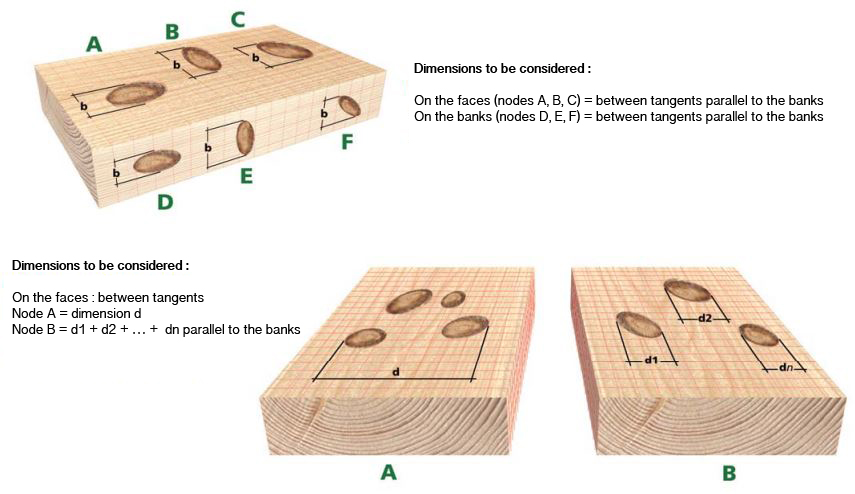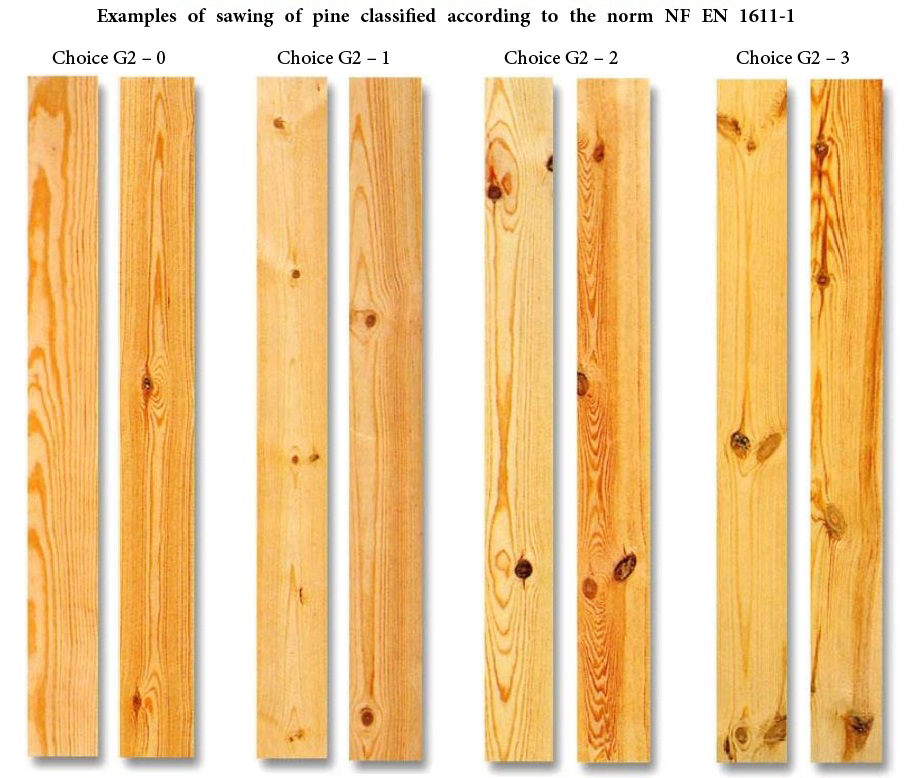Standardised mechanical and aesthetic qualities
A bit of history...
Until 1999, the existing classification combined an appreciation of the appearance of the wood and its structural use (mainly framework).
The options were OA, OB, 1, 2, 3A and 3B
There was also a BS "Construction Wood" classification that permitted the use of average mechanical strength values for the calculation of pine wood structures.
BS quality timber was found only in options 1 and 2.
Today, we distinguish completely between timber selected for aesthetic use and timber selected for structural use.
Mechanical grading (structural use)
Timber can be mechanically classified through a visual grading of the wood, or by using a mechanical classification machine calibrated for the relevant wood variety.
Visual grading:
Visual grading is carried out according to the NF B52-001 standard « Visual grading of French sawn timber for structural use »
This is conducted according to different criteria, including width of the growth rings, diameter of knots, cracks, resin pockets, ingrown bark, fibre deviation, depressions, and biological alterations and deformations.
This sorting places the wood into 4 categories: STI, STII, STIII and STIV.
According to the NF B52-001 standard, these visual grades are directly related to the mechanical strength grades:
STI corresponds to C30 / STII corresponds to C24 / STIII corresponds to C18.
Visual grading into category STI is not carried out in the case of maritime pine, since certain specific features of this species that harm its mechanical resistance are not visible on its external faces. Machine grading is therefore preferable for this species.
Consulting firms that calculate timber structures currently use 3 mechanical grades: C30, C24 and C18.
As a guideline, STII (C18) classified timber is suitable for mounting a timber frame wall or traditional framework.
When the NF B52-001 standard was drafted, certain pine trees had not been tested - the mountain pine, for example. These have since been the focus of a BNBA/CIRAD study for the UNCI PLUS association.
This involved studying the mechanical properties of mountain pine, and led to the species being proposed for the following category/grade correspondences: STI corresponds to C30 / STII corresponds to C20 / STIII corresponds to C16.
This allows the species to be used in construction projects.
Machine grading:
As its name suggests, machine grading involves using a grading machine to test each piece of wood and assess its precise mechanical resistance, using a statistical database for comparison.
The reference standard is EN 519.
There are several types of machines that use different means of measurement, including ultrasound, X-rays, shock, and bending. What each machine has in common is that it must first be calibrated and approved according to the species being measured. A long and typically expensive series of tests are carried out for this purpose.
French pine professionals are now beginning to use these machines. This is in their interest because the machines allow them to make better use of pine wood as a construction material. Indeed, these machines assign certain timber with a mechanical grade that would have been rejected by visual grading. This is because visual grading is a much more precautious grading method.
The machines also make less mistakes and speed up the procedure.
Grading according to appearance (for non-structural purposes)
Since 1999 the reference standard has been NF EN 1611-1.
This allows the grading of sawn wood, and by extension timber planed on all 4 surfaces, because there is no current standard specific to the latter.
This standard defines two ways of grading timber:
- Grading for 2 surfaces only (G2 grade)
- Grading for 4 surfaces (G4 grade)
In both cases, the grading takes into account:
- Knots: dimension and quantity
- The presence of ingrown bark and resin pockets
- Compression wood
- Degradation of the wood
- Depression, pith, cracks, deformations
Five options are possible: 0, 1, 2, 3 and 4, by descending order of quality; figures which should theoretically be preceded by the symbol G2 or G4 according to the grading method used.
For example,
- A piece graded G4-0 signifies that there are no more than 2 knots per metre on any side, and that these knots measure less than 10% of the width of the piece.
- A piece graded G4-4, however, has no limit on the size and number of knots, but the solidity of the piece must not be affected.










